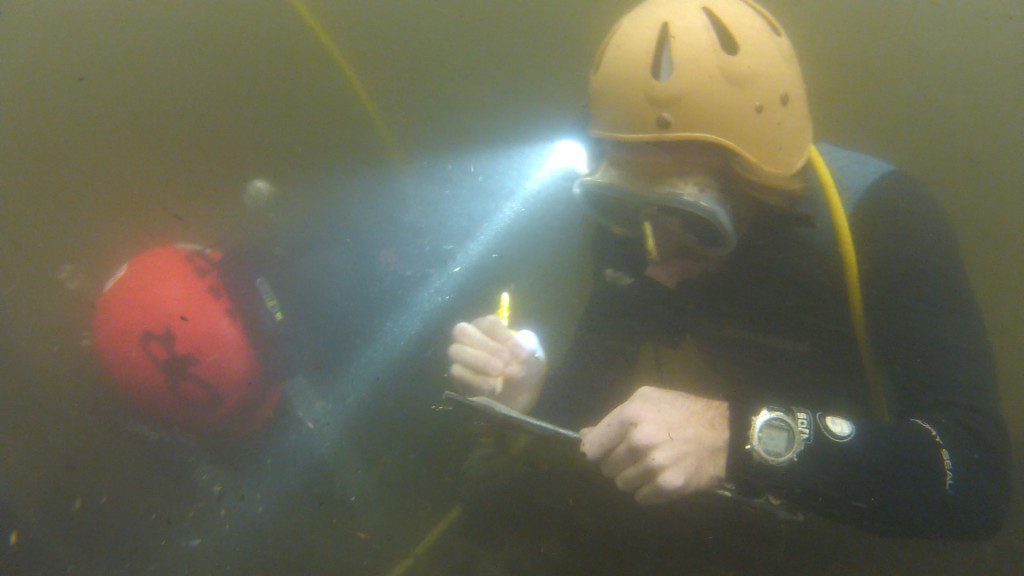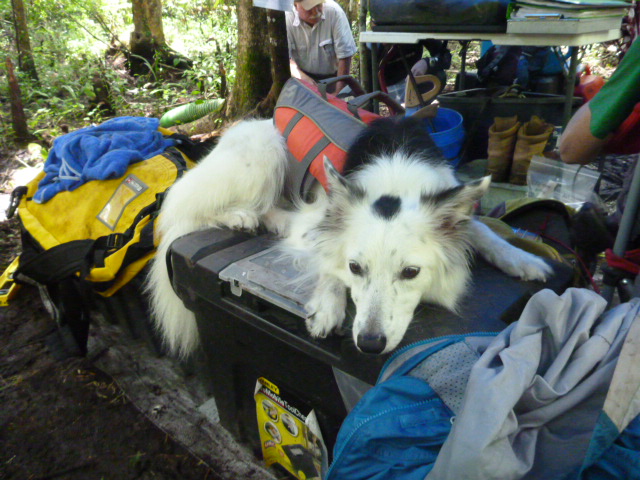The video for this EcoAdventure will air in September as part of a new WFSU program. What segments will air alongside this and other EcoAdventures? That wasn’t a rhetorical question. Come in and have a meal, on us, here at the station. We want this to feel like your show, and we’re listening to your suggestions. Conversations start in two weeks. Spots are limited; we want small groups so that we can hear what you have to say. Visit the WFSU Listens page to sign up for one of five sessions.
Rob Diaz de Villegas WFSU-TV
We were traveling down an undisclosed section of the Wacissa River. Robert Daniels, the retired Florida Fish and Wildlife game warden who transported us in his jon boat, thought our hosts should have been less explicit in describing their location. He preferred to say “the Aucilla River basin” on camera. He was taking us to an archeological site being excavated under the clear water of the river, and he’s fiercely protective of the watershed’s sites. There are dozens of them in the spring-fed Wacissa and black water Aucilla, many of which, along with other Florida sites, are challenging notions about early human settlement in North America. Robert worries about looters, and it’s a legitimate concern. He caught his fair share of them while working with FWC.
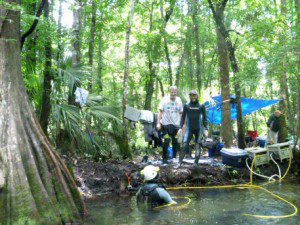 We slowed down as we passed a dive flag hung from a cypress tree. Neoprene dive suits hung from a clothes line. Two yellow tubes and a bigger green one disappeared into the water near two brightly colored domes bobbing in and out. Boots, coolers, and dogs were placed randomly in the heavily tread mud. At the center of the camp hung a blue tarp, sort of a command center. A young bearded man sat under the tarp and examined small ziplock bags with little bits of rock, cataloguing their finds.
We slowed down as we passed a dive flag hung from a cypress tree. Neoprene dive suits hung from a clothes line. Two yellow tubes and a bigger green one disappeared into the water near two brightly colored domes bobbing in and out. Boots, coolers, and dogs were placed randomly in the heavily tread mud. At the center of the camp hung a blue tarp, sort of a command center. A young bearded man sat under the tarp and examined small ziplock bags with little bits of rock, cataloguing their finds.
I was there to see Morgan Smith, a 23 year old Ph.D. candidate at Texas A&M University. He was in the water at the end of one of the yellow tubes. Having grown up in nearby Tallahassee, he’d spent a fair amount of time on this river as a youth. “I kayak it all the time with my friends” Morgan projected over the sound of a motor after he got out. “We’ve gone past this site, you know, half a dozen times and I never really thought anything of it. So it’s funny to be here now.”
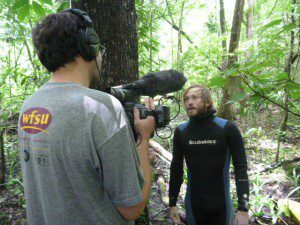
Morgan Smith, Ph.D. candidate at Texas A&M, leads the excavation of an archeological site on the Wacissa River. Here he is interviewed by WFSU producer Rob Diaz de Villegas.
Morgan received an undergraduate degree from the University of West Florida before going to work for the National Park Service at the Southeast Archeological Center in Tallahassee. Watching the news one day, he learned about excavations in the Aucilla and Wacissa being conducted by Dr. Jessi Halligan. He e-mailed her and soon began volunteering on her digs. She then became part of his dissertation committee when he enrolled at Texas A&M, along with his faculty advisor Dr. Mike Waters.
Morgan and his crew, which includes Dr. Halligan, are working their way down a river bank in an attempt to answer questions about people who were likely camping there for a short while (not unlike the archeologists). To get some underwater GoPro footage of the divers, I walked out on the natural bank above their excavation. The bank ended suddenly in a straight vertical drop along which divers, their heads by my feet, would pluck bits of chert to bag. The earth that they had shaved from the river bank was vacuumed up by a green hose and passed through a series of screens. This kept them from losing the smallest artifacts.
After borrowing a snorkel, I jumped down to get a closer look. Unlike the divers, I didn’t wear a weight belt, so I’d occasionally have to grab an exposed root to keep the river flow from messing with the steadiness of my shot. One diver would bag artifacts while the other would catalogue them on waterproof paper. They’d been working their way down the bank five centimeters at a time, slow and methodical. The position of every recovered item was recorded.
Most of what he’s finding are the scraps of tools made about 12,000 years ago. Some of those scraps look to have been further crafted and used as tools themselves. Morgan will take the artifacts back to Texas A&M and look to answer a few questions. What did these people eat when they camped here? Was this river channel here then? And, most importantly, who were the people who stayed here? He may know a little more by the time this video airs in September; we’ll keep you posted.
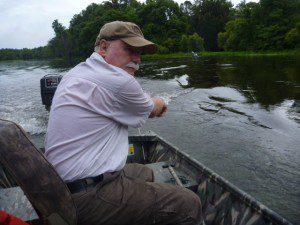
Robert Daniels, retired Florida Fish and Wildlife officer and prospective Aucilla/ Wacissa Riverkeeper.
The answers to these questions, along with information gathered at other sites in this area, will help to clarify our picture of these early Floridians, the first Floridians. As Morgan told us, water preserves artifacts better than dry land. That’s what makes Florida such an interesting place for archeology. But, as Robert Daniels is well aware, that also makes it ripe for looting.
By the time this piece airs, Robert might officially be the Riverkeeper of the Aucilla/ Wacissa watershed. As we reported after our Aucilla River Paddling Trail EcoAdventure, Robert is part of a group looking to start a Riverkeeper group similar to the Apalachicola Riverkeeper. They’re going through the necessary steps, and with the guidance of the Apalachicola group, are looking to join the Waterkeeper Alliance. The Aucilla/ Wacissa River Group, as they are now known, are making the protection of the area’s sites a priority.
It’s a felony to disturb human remains, and a misdemeanor to not report individuals you know to be doing so. Archeological sites are federally protected. Under The Archaeological Resources Protection Act of 1979 (ARPA), a first time felony offender could face a $20,000 fine and a year in jail. A second time offender could face a $100,000 fine and five years in jail.
We’ll keep you posted on both Morgan’s findings and on the Aucilla/ Wacissa River Group. Right now, there’s another dig in the Aucilla’s historic river bed, miles into the Gulf. Dr. Halligan will also be returning to an older site on the Aucilla, one with evidence of humans that is 14,500 years old. Would you like to see us cover more archeology on our EcoAdventures? Let us know.

